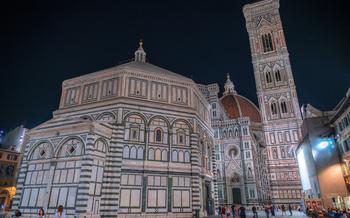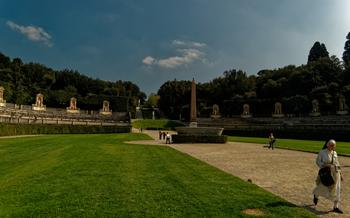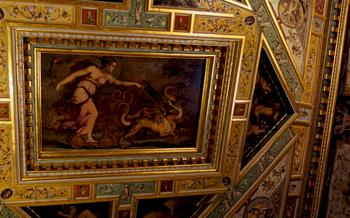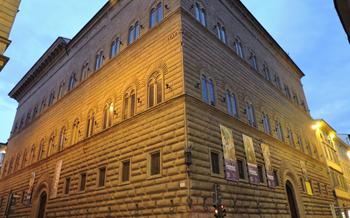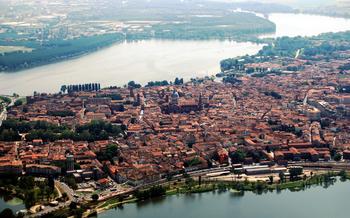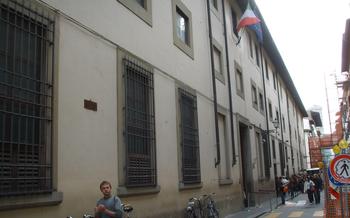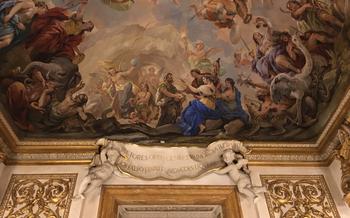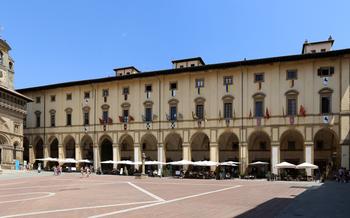
Bardini Gardens
- Introduction
- History
- Location
- Entrance Fees
- Opening Hours
- Layout
- Events
- Guided Tours
- Best Time to Visit
- Food and drinks
- Accessibility
- Photography
- Insider Tip: Unveiling the Hidden Gem of the Bardini Gardens
Introduction
Nested in the heart of enchanting Florence, the Bardini Gardens, a picturesque haven of serenity and beauty, await your presence. These captivating gardens, akin to an emerald oasis, cascade majestically along the enchanting slopes of Costa San Giorgio, offering an enthralling panorama of the resplendent Tuscan capital. From the moment you step through the gates of this botanical sanctuary, prepare to be mesmerized by its timeless elegance, enchanting vistas, and an atmosphere that whispers tales of history, art, and nature's symphony.
History
The Bardini Gardens, originally known as the Bardini-Pecci Garden, have a rich and fascinating history that dates back to the 13th century. These lush gardens were originally part of the estate of the powerful Della Luna family and then belonged to the wealthy Mozzi family, but it was not until the 16th century that they were transformed into a magnificent garden by Niccolò Gaddi, a prominent Florentine architect. In the 19th century, the garden was redesigned by the landscape architect Giuseppe Poggi, who expanded its size and added many of the features that can be seen today, such as the terraces, fountains, and sculptures.
In 1913, the garden was sold to the city of Florence and opened to the public. During World War II, the garden was damaged, but it was later restored and reopened to the public in 196Today, the Bardini Gardens are a popular tourist destination, offering visitors a chance to experience the beauty of an Italian Renaissance garden and enjoy breathtaking views of Florence from its elevated position.
Location
The Bardini Gardens are conveniently located on the hill of Belvedere, just a short distance from the historic center of Florence. To reach the gardens, visitors can take a pleasant stroll from Piazza Pitti along Via Costa San Giorgio or take advantage of the Bardini Funicular, which offers a unique and scenic journey up the hill.
The funicular departs from the Oltrarno district, near the San Niccolò bridge, and takes passengers on a charming ride through the picturesque neighborhood of San Miniato. The journey offers breathtaking views of the city, including the Palazzo Vecchio, the Duomo, and the hills of Fiesole.
Once at the top, visitors will find themselves at the entrance to the Bardini Gardens. Here, they can purchase tickets and begin their exploration of this enchanting oasis in the heart of Florence.
Entrance Fees
The Bardini Gardens offer flexible pricing options to accommodate various budgets. The standard admission ticket costs €10 for adults, providing access to the garden's lush landscapes, panoramic views, and artistic treasures. However, visitors can take advantage of several discounts and free entry options.
Reduced Tickets: - Children between 6 and 12 years old receive a discounted rate of € - Visitors over 65 years old are also eligible for a reduced ticket at € - Students with valid student IDs can purchase tickets for €
Free Admission: - Children under 6 years old are granted free entry to the gardens. - Visitors with disabilities accompanied by a helper or guide are entitled to free admission.
Additionally, the Bardini Gardens offer free entry on the first Sunday of each month, allowing visitors to explore the gardens without any admission costs. These free admission days provide an excellent opportunity for families and budget-conscious travelers to experience the beauty of the gardens without any financial burden.
To purchase tickets, visitors can either book online in advance or buy them directly at the ticket office on-site. Online booking is recommended during peak tourist season or for those who prefer a seamless and convenient ticketing process.
Opening Hours
The Bardini Gardens follow specific opening hours to ensure the optimal experience for visitors while preserving their beauty and tranquility. To plan your visit effectively, it's crucial to be aware of these hours.
The gardens are open to the public from Tuesday to Sunday, granting you ample opportunities to explore their enchanting landscapes. However, it's important to note that the opening hours vary seasonally, reflecting the changing daylight patterns.
During the high season, which falls between April and September, the gates of the Bardini Gardens swing open from 8:30 am to 6:30 pm. This extended window allows you to soak in the gardens' ethereal charm in all its glory.
As the days grow shorter in the shoulder months of October and March, the opening hours shift slightly to 8:30 am to 5:30 pm. While the daylight hours may be shorter, the gardens still offer a magical respite from the city's hustle and bustle.
In the winter months, from November to February, the Bardini Gardens maintain a reduced schedule, welcoming visitors from 8:30 am to 4:30 pm. Despite the shorter days, the gardens retain their captivating beauty, providing a peaceful sanctuary amidst the winter chill.
Layout
The Bardini Gardens are divided into three main terraces, each with its own unique features. The first terrace, located at the lowest level, is home to the Rose Garden, a vibrant display of over 1,200 roses in various colors and varieties. The second terrace, known as the Belvedere Terrace, offers breathtaking panoramic views of Florence, with the Duomo, Palazzo Vecchio, and other landmarks clearly visible. This terrace is also adorned with statues and fountains, creating a picturesque setting for relaxation and contemplation. The third terrace, the highest point of the gardens, features a charming Lemon House, a historic building that was once used to protect lemon trees from the cold winter temperatures. Today, the Lemon House serves as a venue for events and exhibitions.
Events
Throughout the year, the Bardini Gardens host a variety of special events and exhibitions that enhance the visitor experience. Art exhibitions, concerts, and cultural events are frequently held in the gardens, providing an opportunity to immerse oneself in the rich cultural heritage of Florence. During the summer months, the gardens come alive with live music performances, creating a magical atmosphere under the Tuscan sky. One of the most popular events is the "Bardini Music Festival," a series of concerts featuring renowned classical and jazz musicians in the enchanting setting of the gardens. Visitors can also enjoy themed exhibitions that showcase the gardens' history, art, and botanical wonders, offering a deeper understanding of this remarkable green oasis.
Guided Tours
Guided tours of the Bardini Gardens are available for those who want to learn more about the history, architecture, and plant life of this beautiful space. These tours are led by knowledgeable guides who can provide insights and anecdotes that you might not find on your own. They can also help you navigate the gardens and make sure you don't miss any of the highlights, and are offered in a variety of languages, including English, Italian, French, and Spanish.
Benefits of Taking a Guided Tour:
- Learn about the history and significance of the Bardini Gardens from a knowledgeable guide.
- Discover hidden gems and secret spots that you might not find on your own.
- Get personalized recommendations for things to see and do in Florence based on your interests.
- Avoid the crowds and enjoy a more intimate experience of the gardens.
- Take advantage of the opportunity to ask questions and get expert advice on gardening and plant care.
Best Time to Visit
The Bardini Gardens offer a unique and enchanting experience throughout the year, but certain times stand out for an unforgettable visit. Spring, from March to May, brings forth a kaleidoscope of colors as the gardens burst into bloom. Azaleas, roses, and wisteria create a fragrant tapestry, while the air fills with the melodious songs of birds. The mild temperatures and gentle breezes make it an ideal time to stroll through the terraces and soak in the beauty of nature's awakening.
For those seeking a more tranquil experience, autumn, from September to November, offers a quieter charm. The crowds have thinned, and the gardens take on a serene and contemplative atmosphere. The foliage transforms into a vibrant array of golden hues, creating a breathtaking spectacle as the days grow shorter and the air becomes crisp.
Summer, while warm and inviting, can be crowded, especially during the midday hours. However, early mornings and late afternoons provide a more pleasant and relaxed ambiance, allowing visitors to fully immerse themselves in the tranquility of the gardens.
Regardless of the season, visitors are advised to arrive early to avoid the crowds and bask in the morning light that illuminates the gardens, casting a magical glow on the sculptures and fountains.
Food and drinks
While the Bardini Gardens do not have a dedicated restaurant or café, visitors are welcome to bring their own food and drinks to enjoy in the garden's picnic areas. Several benches and tables are scattered throughout the gardens, providing picturesque spots to savor a packed lunch or a snack while soaking in the beautiful surroundings.
For those who prefer to purchase food and drinks, there are several options available within a short walk of the gardens. Along Via dei Bardi, several cafes and bars offer a range of light snacks, sandwiches, pastries, and beverages. For a more substantial meal, visitors can head to the nearby Oltrarno district, where they will find a wide selection of restaurants serving traditional Tuscan cuisine, from trattorias and pizzerias to fine dining establishments.
Accessibility
The Bardini Gardens are generally accessible to visitors with disabilities. The main entrance is equipped with a ramp, and most of the paths are wide and paved, making them easy to navigate with a wheelchair or stroller. However, some areas of the gardens, such as the terraces and the upper parts of the park, may be difficult to access due to steps or uneven terrain.
Visitors with disabilities are advised to inform the staff at the entrance about their needs, and they will be provided with assistance and directions to the accessible areas of the gardens. It is also recommended to plan the visit in advance and check the garden's website for any specific accessibility information or updates.
Photography
Photography enthusiasts will be delighted to capture the beauty of the Bardini Gardens through their lenses. The vibrant colors of the flowers, the intricate details of the sculptures, and the breathtaking views of Florence provide ample opportunities for stunning shots. However, it is important to be respectful of other visitors and the garden's tranquility.
Using a tripod is generally not allowed, as it can obstruct the paths and disturb other visitors. Instead, photographers are encouraged to use a monopod or handheld shooting techniques to minimize disruption. Flash photography is also not permitted, as it can be disruptive and damaging to the artworks.
For those seeking unique perspectives, there are several hidden spots within the gardens that offer exceptional photo opportunities. One such spot is the secluded corner near the Rose Garden, where visitors can capture intimate shots of the roses against the backdrop of the city skyline. Another hidden gem is the terrace overlooking the Boboli Gardens, which provides a breathtaking panoramic view of the neighboring gardens and the surrounding hills.
By following these guidelines and exploring the hidden corners of the Bardini Gardens, photographers can capture the essence and beauty of this enchanting place, creating lasting memories of their visit to Florence.
Insider Tip: Unveiling the Hidden Gem of the Bardini Gardens
Amidst the enchanting allure of the Bardini Gardens, a secret spot awaits discovery, beckoning curious explorers to unravel its hidden charm. Tucked away from the main paths, this secluded oasis offers a tranquil retreat, a sanctuary where time seems to stand still. Follow the winding path that leads you deeper into the gardens until you stumble upon a secluded terrace, adorned with intricate stone carvings and enveloped by vibrant bougainvillea blooms.
Take a moment to bask in the serenity of this hidden gem, where the only sounds are the gentle rustling of leaves and the distant chirping of birds. Let your gaze wander across the breathtaking vista that unfolds before you, a panoramic masterpiece that encompasses the iconic landmarks of Florence. From here, the Duomo's majestic dome pierces the azure sky, the Ponte Vecchio gracefully spans the Arno River, and the rolling hills of Tuscany stretch out into the horizon.
Indulge in the tranquility of this secret haven, where you can escape the bustling crowds and immerse yourself in the beauty of nature. Capture the essence of this hidden gem with your camera, but remember to respect the sanctity of this private sanctuary. As you leave this secluded paradise, carry with you the memory of this unique experience, a cherished secret that will forever linger in your heart.
